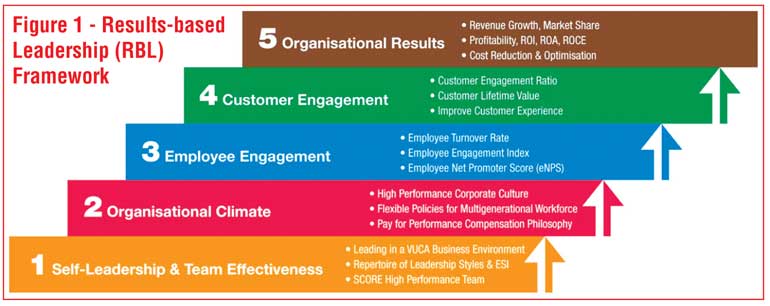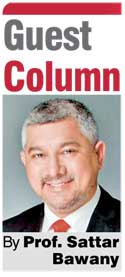Monday Mar 17, 2025
Monday Mar 17, 2025
Tuesday, 12 July 2016 00:01 - - {{hitsCtrl.values.hits}}
“There are two things we can say with certainty about the future: it will be different, and it will surprise. Now, more than ever, leaders have to navigate unfamiliar, challenging times, a quickening pace of change, increasing expectations, and a rising tide of rapidly-evolving conditions. This new and different environment (VUCA) is challenging leaders to find new ways to lead their organisations and achieve sustained success. And, because of these circumstances, there is a thirst for leadership, yet leaders face a whirlwind environment laden with remarkable opportunities and daunting challenges through which to lead their people and organisations” – Bonnie, Hagemann, Prof. Sattar Bawany et al (2016), ‘2016 Research on Trends in Executive Development: A Benchmark Report’

VUCA is an acronym that emerged from the military in the 1990s. It describes the “fog of war” — the chaotic conditions that are encountered on a modern battlefield. Its relevance to leaders in business is clear, as these conditions are highly descriptive of the environment in which business is conducted every day. Leadership as usual, including creating a vision, is not enough in a VUCA world.
In a VUCA world what is needed is Cognitive Readiness: the preparedness and agility to handle the situation at hand and still prevail. Chief among the new VUCA-related competencies that leaders need to develop is a high level of Cognitive Readiness, which is the mental, emotional, and interpersonal preparedness for uncertainty and risk (Hagemann & Bawany, 2016).
Critical Thinking, the more common and tactical of the thinking skills, involves strategic thinking, creative thinking, problem-solving,  and decision-making. It has been a hot topic for the past six years in the EDA Research on Trends for Executive Development. In the latest 2016 Survey, respondents also identified the importance of developing Cognitive Readiness in order to be able to effectively think critically.
and decision-making. It has been a hot topic for the past six years in the EDA Research on Trends for Executive Development. In the latest 2016 Survey, respondents also identified the importance of developing Cognitive Readiness in order to be able to effectively think critically.
Organisations are prioritising the development of Cognitive Readiness as the one of priority for leading in a VUCA business environment. This may reflect recognition of its importance for current and emerging leaders and a serious commitment to developing these mental capabilities, or it may simply reflect curiosity about the latest leadership development topic and a desire to avoid being left behind. Either way, two issues are present.
First, organisations will need to think creatively about the processes they employ to accelerate the development of Cognitive Readiness in High Potential Leaders. Second, organisations may want to explain why, in practice, Cognitive Readiness is important to their success and then define in much greater depth their expectations of perspective.
Traditional Critical Thinking is the ability to recognise assumptions, evaluate arguments and draw conclusions.
The mental tool set typically includes the following:
Cognitive Readiness, on the other hand, is the mental, emotional, and interpersonal preparedness for uncertainty and risk. It complements Critical Thinking by emphasising non-rational, non-logical skills. It is tool set typically includes:
Overall, heightened Cognitive Readiness allows leaders to maintain a better sense of self-control in stressful situations.
There is growing evidence that the range of abilities that constitute what is now commonly known as emotional and social intelligence plays a key role in determining success in life and in the workplace. Extensive longitudinal research by Centre for Executive Education (CEE) has uncovered links between specific elements of emotional and social intelligence and specific behaviours associated with leadership effectiveness and ineffectiveness in developing an impactful organisational climate that is supportive in driving enhanced employee and customer engagement resulting in the achievement of the desired organisation results (See Figure 1).
Managers often fail to appreciate how profoundly the organisational climate can influence financial results. It can account for nearly a third of financial performance. Organisational climate, in turn, is influenced by leadership style—by the way that managers motivate direct reports, gather and use information, make decisions, manage change initiatives, and handle crises. There are six basic leadership styles. Each derives from different emotional intelligence competencies, works best in particular situations, and affects the organisational climate in different ways (Bawany, 2014).
Each style has a distinct effect on the working atmosphere of a company, division, or team, and, in turn, on its financial performance. The styles, by name and brief description alone, will resonate with anyone who leads, is led, or, as is the case with most of us, does both. Commanding leaders demand immediate compliance. Visionary leaders mobilise people toward a vision. Participative leaders create emotional bonds and harmony. Democratic leaders build consensus through participation. Pacesetting leaders expect excellence and self-direction. And coaching leaders develop people for the future.
An organisation’s employees have always made the difference between a truly successful organisation and a mediocre entity, but it’s amazing how often managers overlook or discount this fundamental recipe for economic survival. Organisations with cultures that focus on their people and that invest in their future will in the long-run, be more competitive than cultures that view employees as mere costs to be reduced in times of trouble.
The skills of creating a vision and engaging others around it can be powerfully developed through mentoring and coaching. The “hands-on” approach of mentoring can enable leaders to observe what someone who has mastered these important skills does, and to solicit advice, input, and coaching on how to transfer what they have observed into their own work. It may be more challenging to find a mentor who has also highly developed Cognitive Readiness skills, so being mindful of the mentor’s skillset will be a key to success.
Executive coaching also has significant potential for developing leaders’ capabilities around creating a vision, engaging others around it, and the Cognitive Readiness skills needed for a VUCA environment. This type of coaching would need to be focused on all of the skills in an integrated manner, and the executives, human resources partners, mentors, coaches, and others involved in the development program may agree on specific goals and followed by regular meetings to discuss progress.
References
Bonnie Hagemann, Sattar Bawany et al. (2016), Research on Trends in Executive Development: A Benchmark Report, published by published by Executive Development Associates (EDA); Pearson TalentLens and Performance Assessment Network (PAN), February 2016.
Bonnie Hagemann & Sattar Bawany (2016), Enhancing Leadership and Executive Development - Latest Trends & Best Practices in Leadership Excellence Essentials, Issue 03.2016.
Sattar Bawany (2014), “Building High Performance Organisations with Results-based Leadership (RBL) Framework” in Leadership Excellence Essentials, Issue 11.2014
[Prof. Sattar Bawany is the CEO of the Centre for Executive Education (CEE). He is also concurrently the Regional Managing Director and C-Suite Master Executive Coach of Executive Development Associates (EDA) in Asia Pacific. CEE is the Strategic Partner of EDA in Asia Pacific. Email: [email protected]; Website: www.cee-global.com; LinkedIn:
www.linkedin.com/in/bawany.
Discover Kapruka, the leading online shopping platform in Sri Lanka, where you can conveniently send Gifts and Flowers to your loved ones for any event including Valentine ’s Day. Explore a wide range of popular Shopping Categories on Kapruka, including Toys, Groceries, Electronics, Birthday Cakes, Fruits, Chocolates, Flower Bouquets, Clothing, Watches, Lingerie, Gift Sets and Jewellery. Also if you’re interested in selling with Kapruka, Partner Central by Kapruka is the best solution to start with. Moreover, through Kapruka Global Shop, you can also enjoy the convenience of purchasing products from renowned platforms like Amazon and eBay and have them delivered to Sri Lanka.
Discover Kapruka, the leading online shopping platform in Sri Lanka, where you can conveniently send Gifts and Flowers to your loved ones for any event including Valentine ’s Day. Explore a wide range of popular Shopping Categories on Kapruka, including Toys, Groceries, Electronics, Birthday Cakes, Fruits, Chocolates, Flower Bouquets, Clothing, Watches, Lingerie, Gift Sets and Jewellery. Also if you’re interested in selling with Kapruka, Partner Central by Kapruka is the best solution to start with. Moreover, through Kapruka Global Shop, you can also enjoy the convenience of purchasing products from renowned platforms like Amazon and eBay and have them delivered to Sri Lanka.